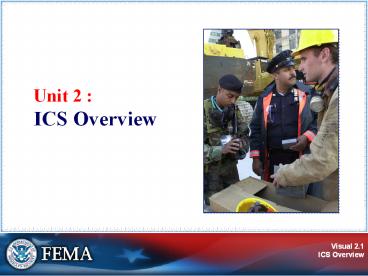ICS Overview - PowerPoint PPT Presentation
1 / 12
Title:
ICS Overview
Description:
Title: ICS200 Author: Sharon Last modified by: Mallery, Guy Created Date: 12/3/2004 5:53:15 PM Document presentation format: On-screen Show (4:3) Other titles – PowerPoint PPT presentation
Number of Views:142
Avg rating:3.0/5.0
Title: ICS Overview
1
Unit 2
- ICS Overview
2
Unit Objectives
- Identify
- Three purposes of ICS.
- Requirements to use ICS.
3
What Is ICS?
- ICS
- Is a standardized, on-scene, all-hazards incident
management concept. - Enables a coordinated response among various
jurisdictions and agencies. - Establishes common processes for planning and
management of resources. - Allows for integration within a common
organizational structure.
4
When Is ICS Used?
- ICS can be used to manage
- Natural hazards.
- Technological hazards.
- Human-caused hazards.
- Planned events.
5
What Is an Incident?
- An incident is . . .
- . . . an occurrence or event, natural or
human-caused, that requires a response to protect
life or property.
6
Why Use ICS?
1. It Works!
2. Mandates
7
National Incident Management System (NIMS)
What ? . . . NIMS provides a consistent
nationwide template . . . Who? . . . to enable
Federal, State, tribal, and local governments,
the private sector, and nongovernmental
organizations to work together . . . How? . . .
to prepare for, prevent, respond to, recover
from, and mitigate the effects of incidents
regardless of cause, size, location, or
complexity . . . Why? . . . in order to reduce
the loss of life and property, and harm to the
environment.
8
NIMS Components ICS
Preparedness
Communications and Information Management
Incident Command System
Resource Management
Multiagency Coordination Systems
Command and Management
Ongoing Management andMaintenance
Public Information
Additional Information www.fema.gov/emergency/ni
ms
9
Discussion Question
- What are common causes of incident response
problems?
10
Lessons Learned
- Without ICS, incident responses typically
- Lack accountability.
- Have poor communications.
- Use unsystematic planning processes.
- Are unable to efficiently integrate responders.
11
ICS Benefits
- ICS helps to ensure
- The safety of responders, workers, and others.
- The achievement of response objectives.
- The efficient use of resources.
12
Summary
- ICS
- Is a standardized management tool for meeting the
demands of small or large emergency and
nonemergency situations. - Represents best practices, and has become the
standard for emergency management across the
country. - May be used for planned events, natural
disasters, and acts of terrorism. - Is a key feature of NIMS.































